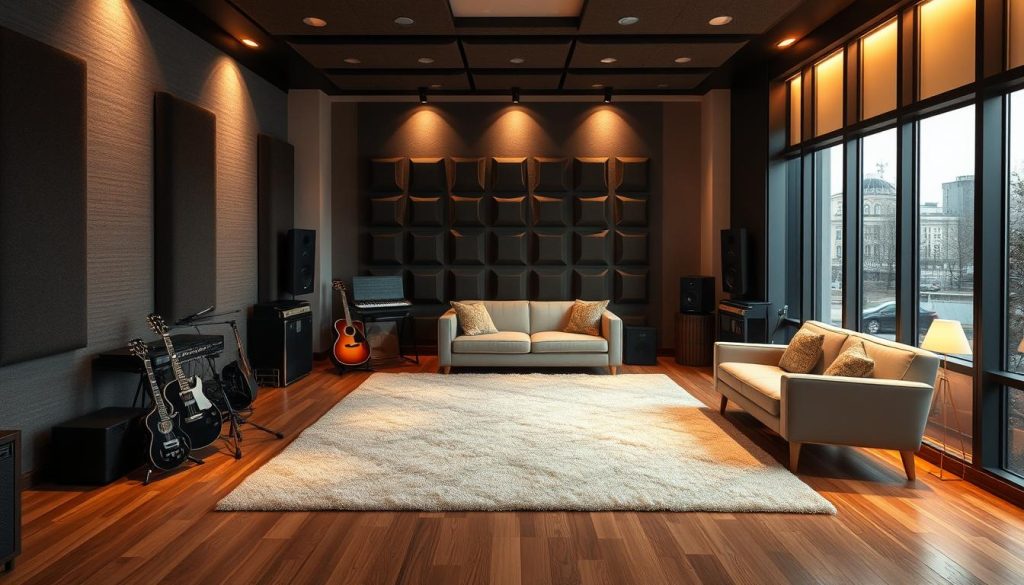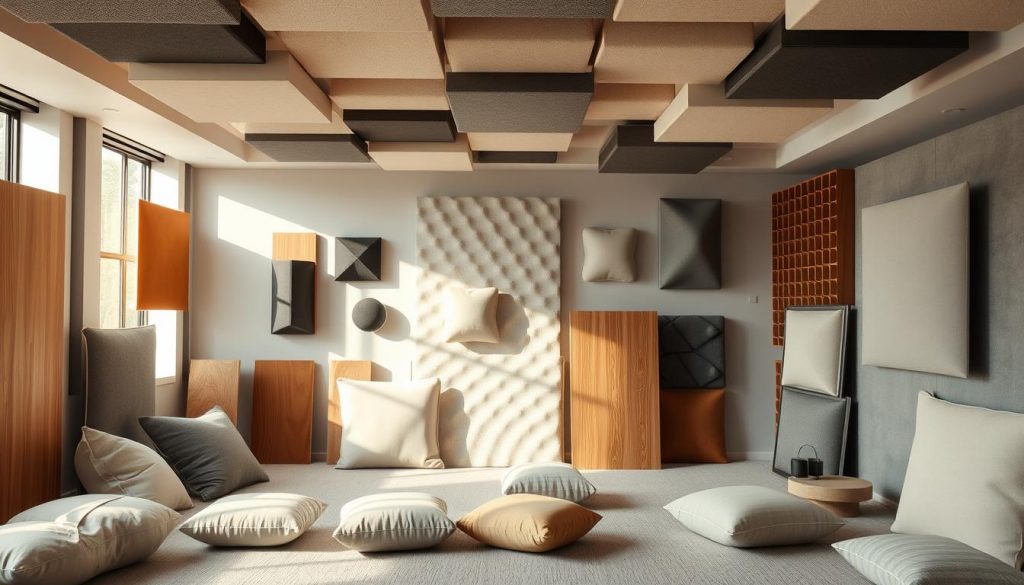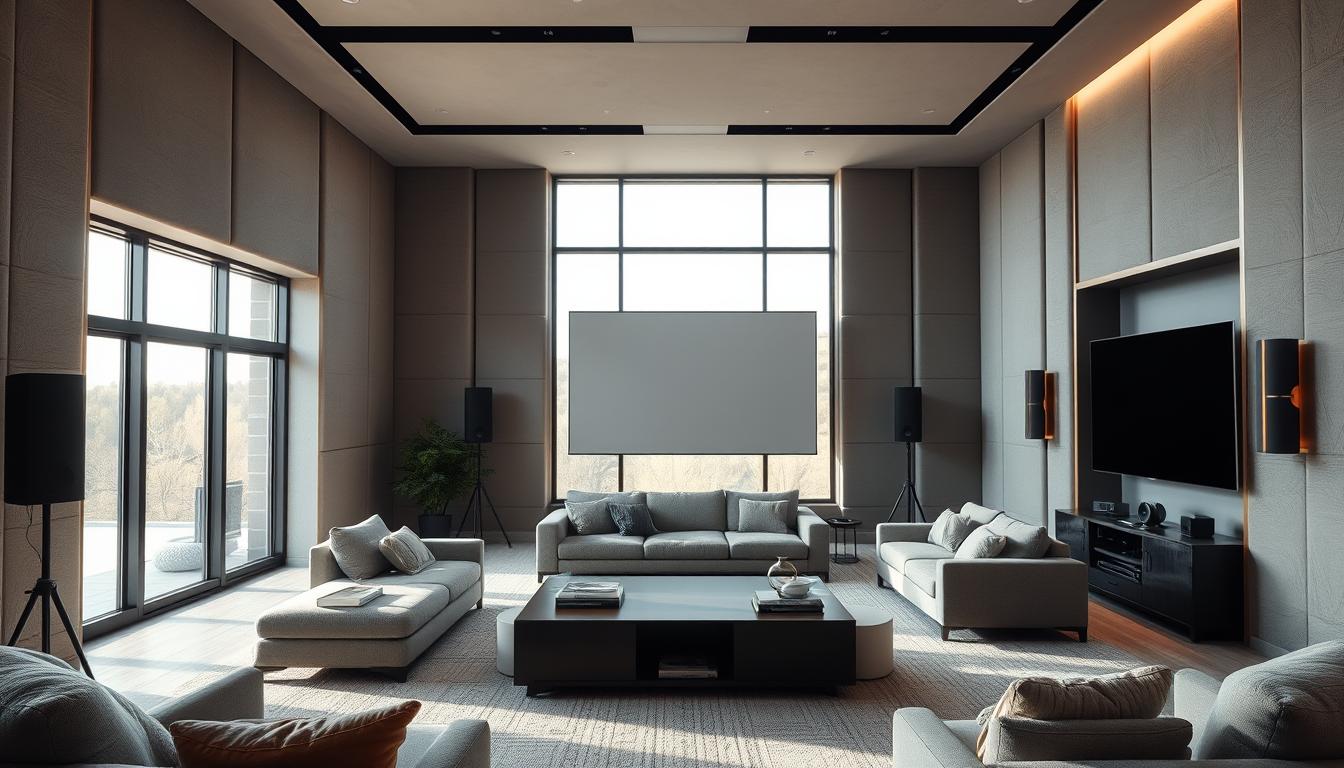I love how design and sound work together. Room acoustics is all about how sound moves in spaces. It changes how we hear music or voices.
The size, materials, and setup of a room affect sound waves. This shapes the sound’s clarity and feel. It makes music or voices sound better or worse.
Setting up a home theater or music studio? Knowing about room acoustics is crucial. It helps make your space sound amazing. You can make your room sound like a dream.
This article will cover room acoustics. We’ll look at how sound works, common issues, and how to fix them. By the end, you’ll know how important room acoustics is. You’ll also know how to make your space sound great.
Understanding the Fundamentals of Room Acoustics
Learning about room acoustics is key to making great sound experiences. How sound moves in a room changes the audio quality. Below the Schroeder frequency, sound waves make standing waves and room resonances. This leads to distortions and uneven sound.
Sound Propagation in Enclosed Spaces
After the Schroeder frequency, sound acts like light, bouncing off surfaces. This is called sound diffraction and diffusion. It affects how good the audio sounds. Knowing this helps fix issues like uneven sound and echoes.
Factors Affecting Room Acoustics
The reverberation time is important in room acoustics. It’s how long it takes for sound to fade by 60 dB. It depends on the room size and how much sound-absorbing materials are there.
Room modes, or standing waves, also change the sound. They make the sound uneven across the room. Room size, shape, and materials affect sound too. Using absorptive and diffusive materials helps improve the room’s acoustics and sound quality.
Tackling Common Acoustic Issues

In the audio world, standing waves and room modes are big problems. They can mess up sound quality, making bass uneven and sound unclear. But, you can fix these issues with the right methods.
Addressing Standing Waves and Room Modes
Standing waves happen when sound waves bounce off parallel walls. This creates bad resonances that make bass sound too much or too little in some spots. Putting bass traps in corners helps solve this. These traps soak up the energy of standing waves, making bass sound even and clear.
Flutter echo is another problem, caused by sound bouncing off parallel walls. It makes midrange and treble sound harsh and unclear. But, using sound-absorbing materials in the right spots can fix this. This makes the sound focused and clear.
| Acoustic Issue | Causes | Solutions |
|---|---|---|
| Standing Waves | Parallel reflective surfaces | Bass traps in room corners |
| Flutter Echo | Parallel walls | Sound-absorbing materials |
Fixing these acoustic problems can make your audio setup amazing. With the right methods for standing waves, room modes, and acoustic treatment, you’ll get the sound quality you want.
room acoustics Treatments and Solutions

Getting great sound in any room starts with knowing about room acoustics. Sound absorption and diffusion are key to a good soundscape. Using the right mix of absorptive materials and diffusion can change your space for the better.
Absorptive Materials for Sound Control
Things like acoustic panels, curtains, and rugs are vital for controlling sound. They turn sound energy into heat, stopping it from bouncing back. Placing these at key spots can make the sound clearer and better.
Diffusion: Scattering Sound Waves
Sometimes, just absorbing sound isn’t enough. It can make a room feel too quiet. That’s where diffusion comes in. It spreads sound waves, keeping the room feeling big and alive.
Using sound-absorbing materials and diffusion can make your space sound amazing. It makes the sound balanced and enjoyable.
Acoustic Treatment Strategies
Creating a good acoustic treatment plan is key for better sound in any room. It’s useful for improving sound in home theaters, studios, or even small offices. The right mix of absorptive and diffusive materials in the right spots makes a big difference.
Acoustic treatment aims to fix issues like standing waves and room modes. These problems can make sound uneven and poor quality. Using acoustic panels on walls helps absorb sound waves and balances the sound.
Diffusion is also crucial. It spreads sound waves so they don’t focus in one spot. You can use special panels or furniture to do this.
When making an acoustic treatment plan, think about the room’s size, shape, and materials. This helps make a room acoustics optimization plan that improves sound quality everywhere.
The aim is to get a natural, balanced sound that pulls you into the music or movie. With the right mix of absorbers and diffusers, any room can become a place where sound comes alive.
Designing for Optimal Acoustics
Designing a space with great acoustics is key. The room’s size and shape are very important. They affect how sound waves move and sound quality.
Room Dimensions and Shape Considerations
Rooms shaped like a perfect cube can be bad for sound. They make standing waves that cause uneven sound. But, rooms that are not symmetrical can spread sound better, making it sound more natural.
The size of the room matters a lot for sound. The Schroeder frequency shows the best time for sound to echo. Knowing this helps make a room sound its best.
| Room Dimensions | Impact on Acoustics |
|---|---|
| Cube-shaped rooms | Prone to standing waves and room modes, leading to unbalanced sound |
| Asymmetrical or irregularly shaped rooms | Help diffuse sound for a more natural, balanced acoustic environment |
| Schroeder frequency | Determines the optimal reverberation time for the space |
Think about the room’s size and shape when designing. This way, you get a space with amazing acoustic design and optimal acoustics. Your room design will look and sound great.
Enhancing Specific Spaces for Better Sound Quality
Room acoustics can be fine-tuned for different spaces. In a home theater, I aim for clear sound and control of low sounds. Music studios need precise sound control for accurate sound.
Conference rooms focus on clear speech. Churches want a warm, echoing sound for music and singing. I tailor my acoustic treatments to each space’s needs.
Whether it’s for a home theater, music studio, conference room, or church, the goal is to use room acoustics wisely. This way, I can make any space sound amazing.

